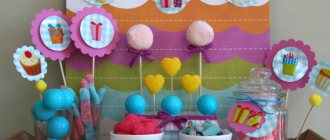The closer the New Year holidays are, the more desires and ideas appear on decorating your apartment to please your family and friends. Interesting and simple ways will help you create toys, garlands and even a Christmas tree yourself, using inexpensive materials. The main thing is that the New Year's decor for the home is combined with the style of the interior.
Which style to choose
The choice of style is influenced by the number and size of rooms, the nature of those present and the corresponding interests. It is also worth considering the purpose of the room. The living room is decorated discreetly - with European motifs or in Scandinavian style.
New Year's decor is selected so that it harmonizes with the uniform style direction of the apartment. Moreover, it should look solemn and festive.
Before preparing the house for the New Year, they draw up a plan indicating the location of the Christmas tree, garlands and other decorations. In the Year of the Mouse, designers advise decorating an apartment without frills and unpretentiousness.
Hello Dedushka Moroz!
Paradoxical as it may seem, the Russian Middle Ages did not know such characters. At least, in the guise we are used to today. They first appeared less than 200 years ago, closer to the middle of the 19th century, as literary heroes. But completely unrelated to the tradition of celebrating the New Year.
Photo: TASS/DPA/Patrick Pleul
Portrait of Father Frost and Snow Maiden and how much they earn in Russia
About the demand for the services of New Year's animators and their fees - in the new Izvestia infographic
This happened after the Decembrist uprising. The aristocracy was no longer perceived as the support of the throne, and the search for new ideological bonds began. The famous Uvarov triad of “autocracy, Orthodoxy, nationality” appeared. Accordingly, the need arose for new symbols and images. Works in pseudo-folk fairy tale or epic style have become fashionable. It was then that a certain Moroz Ivanovich appeared in “The Tales of Grandfather Iriney” by Vladimir Fedorovich Odoevsky (the first edition was published in 1840), and almost simultaneously in Nikolai Nekrasov - Moroz the Red Nose. Of course, these were not yet finished images, but only their forerunner. A little later, the Snow Maiden appeared - Alexey Nikolaevich Ostrovsky wrote the play of the same name in 1873 under the influence of the work of the historian and ethnographer A.N. Afanasyev "Poetic views of the Slavs on nature." The famous playwright used only his name and came up with the plot himself. By the way, there the Snow Maiden appears as the daughter of Father Frost and the mysterious Spring-Red. After some time, Vladimir Ivanovich Dahl’s fairy tale “The Snow Maiden Girl” appeared, and Nikolai Andreevich Rimsky-Korsakov wrote the opera “The Snow Maiden”. Perhaps it was she who became the main milestone in the formation of the image of the Snow Maiden. The opera was staged at the Bolshoi and was a great success. V.M. depicted the heroine on his canvases. Vasnetsov, N.K. Roerich and M.A. Vrubel. The names of Father Frost and Snow Maiden gradually became familiar and familiar, but they were in no way connected with the holiday of Christmas or New Year.
Naturally, the question arises: when did these characters unite and gain the fame that surrounds them now? It turns out that only at the dawn of the twentieth century, with the beginning of the era of capitalism. To some extent, it was a copy of what was happening in the West. After all, Santa Claus is almost the same age as Father Frost, he also comes from the century before last. Except that he appeared several decades older. So let's start with Santa's appearance.
Choosing a color palette
For variety and brightness, 3 contrasts are added to the obligatory New Year's green color. Designers offer gold, silver and red tones. An interesting option is obtained using blue, purple and aqua shades.
An original and bold option, when decorations and New Year’s home decor are in the same color. Then silver decorations are added to the cold tones of the room, and golden and bright red colors are added to light colors.
Generous Kutya
What dishes were typical for this treat? The festive table on Vasilyev's evening would not be complete without three main dishes: porridge, suckling pig and bread. So, the first dish is kutia - a sweet porridge, which was cooked from various grains: initially from wheat or barley, later from rice, sometimes from peas. The porridge got its sweet taste thanks to honey, which was certainly added to it. Kutia was prepared as a ritual dish on many occasions, for various calendar holidays, and always for funerals. But on Vasilyev's evening she was an indispensable part of the treat. Hence another popular name for the holiday - Generous Kutya. In the Minsk province it was believed that the first spoon of kutya should be offered to Saint Basil, saying: “Vasil, Vasil, hodzi kutstyu estsi.” Russian peasants offered kutya to frost: “They cook kutya wheat, salotku, zavut maroz: Maros, maros, khadi kutty is” (recorded by dialectologists in the Pskov region).
The 17th century English traveler Richard James wrote that kutia is a dish “prepared from whole rye (grain) and peas, boiled with honey. They [Russians] bring kutya to church four times a year on Saturdays, for example on St. Demetrius Saturday, October 23, and so on. When the priest says prayers over it, they take it home and, eating it, pray to God to have mercy on the souls of their relatives, and believe that this helps them a little.”
Cooking porridge on Vasily’s Day and the customs associated with it were described by Apollo of Corinth in his essay “People’s Rus'” (1900): “Vasil’s porridge is cooked early, even before dawn. The big woman takes the cereal from the barn after midnight; The owner of the road brings water from the well at the same time. Both are placed on the table, and everyone moves away at a distance. The oven will light up, it’s time to mash the porridge, the family sits around the table, there is only one big woman (the eldest in the house) standing, stirring the porridge, and she laments: “We sowed and grew buckwheat all summer, our buckwheat was born both large and blush; they called and invited our buckwheat to visit Tsar Grad and feast at the prince’s feast; Our Greek woman went to Constantinople to visit the princes, the boyars, honest oats, golden barley; we waited for buckwheat, we waited at the stone gates; The princes and boyars greeted the buckwheat, sat the buckwheat at the oak table to feast; our buckwheat has come to visit us”... Following this saying, the hostess takes a pot of porridge, everyone gets up from the table: the porridge is placed in the oven. While waiting for the porridge guest, they while away the time with games, songs and all sorts of jokes. But here she is in time. The big woman takes her out of the stove, and she herself again with her red words: “You are welcome to come into our yard with your goods!” Everyone starts looking at the pot to see if it’s full. There is a popular belief that says that “if Vasilyev’s porridge creeps out of Vasily’s nest, expect trouble for the whole house!” It’s also not good if the pot cracks: then the household will not be able to do without considerable damage! They will skim off the foam, and again there will be a new omen: the red porridge will pour out - a full cup of all happiness and talent, the white - all sorts of dashing unexpected things. If they have lucky signs, they eat the porridge clean; if they are thin, they throw it into the hole along with the pot.”
History of the Russian New Year tree
1818 - Grand Duchess Alexandra Feodorovna proposed to organize a Christmas tree first in Moscow, and next year in St. Petersburg. The choice fell on Anichkov Palace.
More: How to choose a snow blower
1828 - Alexandra Feodorovna, already an empress, organized the first children's Christmas tree. Five of his own children and nieces are invited to the Christmas tree in the palace.
1852 - the first public Christmas tree was installed at the Ekateringofsky station in St. Petersburg.
Christmas trees were decorated with children's toys and baked sweets, which were wrapped in gold, silver and colored foil. The branches were also decorated with small candles. Later they sold German Christmas tree decorations.
Gradually, Russian artisans mastered and began producing New Year's decorations. To make toys they used cotton wool, fabric, papier-mâché and glass.
Russian style for decorating a Christmas tree
The Christmas tree is the central element of New Year's decor for the home, so it is designed so that it stands out among the rest of the decoration. But at the same time, you should not hang the branches with toys; 1-2 per branch is enough.
The jewelry of the Russian forest beauty consists of the main Russian symbols, traditional Russian crafts and ornaments:
- Gzhel, Khokhloma patterns with Russian northern ornaments;
- clay Dymkovo or Bogorodsky toys made of wood;
- toys from Shemogodskaya carved birch bark;
- from openwork lace;
- from Gusev crystal;
- straw wicker toys in ancient Russian traditions.
Traditionally, coniferous trees are decorated with small plush toys and fabric dolls, which are easy to sew yourself. You should definitely hang sweets in bright wrappers, decorate the branches with Tula gingerbread cookies and homemade glazed cookies, gilded nuts and cones.
More often they choose one folk craft and decorate the tree, adhering to this style. Some people prefer to combine 2-3 directions. Under the spruce tree there are Father Frost and the Snow Maiden, bunnies, bears, sleighs, pine cones and colorful balls.
Style options:
- Figures of national images.
- Animals and ancient Russian objects associated with the New Year and winter.
- Traditions and images of the Russian village.
The main condition for New Year's home decor is laconicism, naturalness and natural color, while glitter should be avoided.
DIY decorations and New Year's decor for the home
Christmas trees
To create a festive atmosphere, all rooms of the apartment are decorated with original Christmas trees.
Paint the cones white or silver, apply glitter and lay out an elegant Christmas tree. Decorate with cotton wool, candles, balloons or shiny rain. An interesting Christmas tree is made from tinsel or fir branches attached to the wall.
More: How to visually increase the space of a room
Also suitable for original Christmas trees: beads, candies, pasta, electric garlands, colored threads and many other improvised means.
New Year's home decor from garlands
Children can make garlands made of foam plastic, paper, fabric, plastic parts and other materials. For fastening, office glue, PVA, tape, stapler, paper clips or colored rain are suitable.
Simple and interesting garlands are made from paper snowflakes, chains, candy wrappers, and fabric flags.
To make a chain, cut strips of 10-15 cm, 1 cm wide. First, glue the first ring, then thread the next strip into it and glue it. Continue this way until the desired length of the garland. The finished chain is decorated with snowflakes, lanterns and other crafts.
The figurines of ballerinas with skirts made of paper snowflakes look original.
Restoration of toys
Antique Christmas tree decorations can also be used by children to paint, repair cotton figures, and put metal loops in place.
In addition, worn-out toys are restored using textiles, yarn, and felt.
Visit on January 1
Konstantin Trutovsky. Carols in Little Russia (fragment). 1800s State Russian Museum, St. Petersburg
Zinaida Serebryakova. Katya in blue at the Christmas tree (fragment). 1922. State Museum of Fine Arts named after A.S. Pushkin, Moscow
Fedot Sychkov. Waits. Children of the old village (fragment). 1935. Mordovian Republican Museum of Fine Arts named after S. D. Erzya, Saransk, Republic of Mordovia
The tradition of long New Year holidays in Russia began a long time ago. In the 19th century, celebrations began with the arrival of Christmastide, a whole series of holidays. We started walking on December 24 (January 6, new style) - Christmas Eve; December 25 (January 7) celebrated Christmas; January 1 (January 14) - New Year and January 6 (January 19) - Epiphany. Officially there were only four days off, but in reality people celebrated for almost two weeks.
Church and secular traditions were closely connected. On Christmas night they went to caroling, and in the morning they went to church for a solemn service. Churches in big cities were often overcrowded, and they even sold tickets for the Christmas service, which were not easy to get. On the same day they visited friends, relatives and went on “visits”. During the day we managed to visit several houses and everywhere we raised toasts in honor of the holiday and treated ourselves to Christmas dishes.
Throughout the holidays, rich and noble families held dinner parties, lavish balls and masquerades. According to the rules of etiquette, New Year's visits could be made throughout January, but it was considered the most polite to visit guests on the 1st.
Luxurious holidays were also held in expensive restaurants. Fyodor Chaliapin described the New Year's Eve in Moscow's Yar: "Mountains of fruit, all varieties of balyk, salmon, caviar, all brands of champagne and all humanoids - in tailcoats."
Ordinary people entertained themselves with ice slides and sleigh rides. There were booths in big cities, and fireworks were set off on Vorobyovy Gory.
At the end of the 19th century, Christmas cards appeared. They were sent not only to relatives who live in other cities, but also to neighbors down the street. We tried to make the text of the congratulations as beautiful as possible. They even published letter books - books with recommendations on how best to congratulate relatives or superiors “as a tribute to courtesy and delicacy.”
"Your Majesty! Congratulating you on the New Year, I sincerely wish you all the best in life and pray to God to prolong your days, the continuation of which is undoubtedly associated with my own well-being." "My dear and kind mother! The first of January is the happiest day: the very heart is reaching out to you to wish you health, happy days and everything that you can wish for yourself.” “Kind and sweet grandmother! Your little granddaughter wishes you a Happy New Year and wishes you to live many, many happy years in joy and fun. Oh, how I would like to hug and kiss you, my dear grandmother. But evil fate does not give me such happiness.”
New Year's home decor in the year of the mouse
The mouse is considered a pet, and accordingly, preference should be given to the rustic Russian style. The white mouse begins a new 12-year round, which is why New Year's home decor is chosen with white, gray and silver metallic shades.
If the interior is of a different color, then small figurines of white and silver rats and mice are placed and the rooms are decorated with themed souvenirs.
Natural and decorative materials will add comfort and warmth. Baskets, cupcakes, and wooden bowls with sweets, fruits and nuts are placed on shelves, on tables, and even on the floor. The decoration should be complemented with woven multi-colored or white napkins and homemade rugs.
Menu
The treats are hearty, plentiful and for every taste! The table should literally be bursting with a variety of fish, meat and vegetable dishes on the menu - a traditional feast.
Several options for maintaining style (original Russian folk treats):
- game, porridge with mushrooms or meat, baked pig, okroshka, casserole, goose with apples, roast;
- jellied or baked fish, caviar;
- a variety of pickles and marinades (cabbage with cranberries, vegetables and mushrooms, pickled apples);
- berries, jam and jam, pancakes and bagels, cheesecakes and pies, rolls and kulebyaki.
If you are celebrating a birthday, order a cake in Russian folk style - a wonderful surprise for the party guests and the birthday boy!
A couple of themed signature dishes will be enough. Or you can even arrange a buffet table by arranging porridge, game and roast in miniature baskets/tartlets. It will turn out interesting and very tasty! And there will be strength left for “singing and dancing.”
Don’t forget about the table decoration - a samovar, painted or simple rustic dishes, national patterns on the tablecloth and napkins. But the main decoration should be the dishes themselves.
Think about drinks to keep the theme going. Of course, mead (easy to make yourself, but it will take about 5 days to ferment), vodka (change the labels or pour into decanters) and kvass (in pot-bellied clay jugs). If you can find an oak barrel and a traditional ladle, use it to pour the beer, at least at the beginning, for atmosphere. Non-alcoholic products include herbal teas, compotes and juices.








